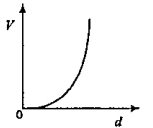How will the voltage (V) between the two plates of a parallel plate capacitor depend on the distance (d) between the plates, if the charge on the capacitor remains the same?




To determine how the voltage (V) between the two plates of a parallel plate capacitor depends on the distance (d) between the plates when the charge (Q) remains constant, we can follow these steps:
1. Understand the Capacitance Formula:
The capacitance (C) of a parallel plate capacitor is given by the formula:
C=Aϵ0d
where:
- C is the capacitance,
- A is the area of the plates,
- ϵ0 is the permittivity of free space,
- d is the distance between the plates.
2. Relationship Between Charge, Capacitance, and Voltage:
The relationship between charge (Q), capacitance (C), and voltage (V) is given by:
Q=C⋅V
Rearranging this gives:
V=QC
3. Substituting the Capacitance Formula:
Substitute the expression for capacitance into the voltage equation:
V=QAϵ0d=Q⋅dAϵ0
4. Analyzing the Relationship:
From the equation V=Q⋅dAϵ0, we can see that:
- Voltage V is directly proportional to the distance d between the plates when the charge Q is held constant.
- This means that if the distance d increases, the voltage V will also increase, assuming Q, A, and ϵ0 remain constant.
5. Graphical Representation:
If we were to plot a graph of V versus d:
- The graph would be a straight line with a slope of QAϵ0, indicating a linear relationship.
- The line would not pass through the origin because when d=0, V would theoretically be undefined.
Conclusion:
Thus, the voltage V between the two plates of a parallel plate capacitor is directly proportional to the distance d between the plates when the charge Q remains constant.
The capacitance (C) of a parallel plate capacitor is given by the formula:
C=Aϵ0d
where:
- C is the capacitance,
- A is the area of the plates,
- ϵ0 is the permittivity of free space,
- d is the distance between the plates.
The relationship between charge (Q), capacitance (C), and voltage (V) is given by:
Q=C⋅V
Rearranging this gives:
V=QC
Substitute the expression for capacitance into the voltage equation:
V=QAϵ0d=Q⋅dAϵ0
From the equation V=Q⋅dAϵ0, we can see that:
- Voltage V is directly proportional to the distance d between the plates when the charge Q is held constant.
- This means that if the distance d increases, the voltage V will also increase, assuming Q, A, and ϵ0 remain constant.
If we were to plot a graph of V versus d:
- The graph would be a straight line with a slope of QAϵ0, indicating a linear relationship.
- The line would not pass through the origin because when d=0, V would theoretically be undefined.
Thus, the voltage V between the two plates of a parallel plate capacitor is directly proportional to the distance d between the plates when the charge Q remains constant.
Topper's Solved these Questions
Similar Questions
Knowledge Check
As the distance between the plates of a parallel plate capacitor decreased
Achances of electrical break down will increases if potential difference between the plates is kept constant.Bchance of electrical break down will decreases if potential difference between the plates is kept constant.Cchance of electric break down will increases if charge on the plates is kept constantDchance of electrical break down will decrease if charge on the plate is kept constant.Force of attraction between the plates of a parallel plate capacitor is
Aq22ε0AKBq2ε0AKCq2ε0ADq22ε0A2KThe separation between the plates of a charged parallel-plate capacitor is increased. The force between the plates
AincreasesBdecreasesCremains sameDfirst increases then decreases
The distance between the plates fo a parallel plate capacitor is d. A metal plate of thickness d/2 is placed between the plates, what will be the new capacity ?
View SolutionThe' distance between the plates of a parallel plate capacitor is d. A metal plate of thickness d/2 is placed between the plates. What will e its effect on the capacitance.
View SolutionHow will the electric field between the plates in parallel plate capacitor change, if the charge on the plates is doubled?
View SolutionThe distance between the plates of a parallel plate capacitor is d. A metal plate of thickness d/2 is placed between the plates, without touching either of the two plates. What will be the new capacity ?
View SolutionThe terminals of a battery of emf V are connected to the two plates of a parallel plate capacitor. If the space between the plates of the capacitor is filled with an insulator of dielectric constant K, then :
View Solution

